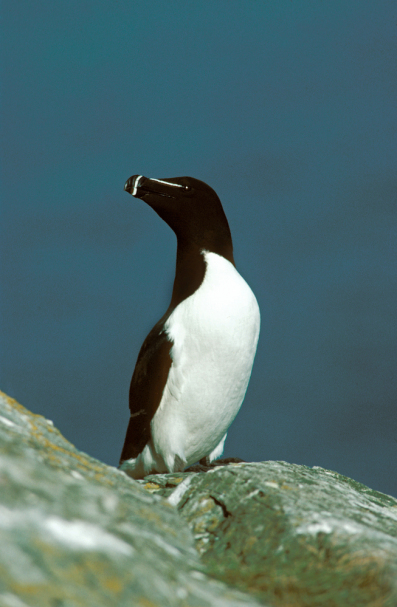
The Razorbill(Alca torda), also known as the Razor-Billed Auk, or Lesser Auk is a seabird that is classified in the Auk(Alcidae) family
Physical Characteristics
Breeding adults are black on their backs, and their torso and belly are white. They have a white line on their bill, and there is a white band around the front of the bill. In the nonbreeding season an adult Razorbill’s throat is white.
| Length | 43 cm(1’5″) |
| Wingspan | 63-68 cm(2’1″-2’3″) |
| Weight | 505-890 gm(1-1.96 lbs.) |
Range
In North America the Razorbill can be found in; Atlantic Canada, Quebec, Ontario, Nunavut, New Jersey, New York, and Maine. The Razorbill can occasionally be seen in Florida, and Virginia. In Europe Razorbills can be found in Scandinavia, the British Isles, Russia, France, Germany, Iceland, Estonia, northern Portugal, and Poland. You can also occasionally see a Razorbill in Morocco.
Habitat
During the breeding season it can be found on rocky islands. The Razorbill winters in the ocean.
Breeding
The male Razorbill picks the nest site which is typically on a rocky island or cliff. Sometimes a mated pair might use old nesting burrows of Atlantic Puffins. The breeding season is usually from late April to May. The female usually lays one egg a year. Both the male and female take turns incubating the egg for about 35 days. The eggs are ovoid-pyramidal in shape, and are cream colored and are covered in brown spots.
You can see Razorbill breeding colonies in North America and Europe, including areas such as:
- Baccalieu Island, Newfoundland and Labrador, Canada
- Gannet Islands, Newfoundland and Labrador, Canada
- Cape St. Mary’s, Newfoundland and Labrador, Canada
- Witless Bay, Newfoundland and Labrador, Canada
- Heligoland, Germany
- Látrabjarg, Iceland
- Runde, Norway
- Staple Island, Outer Farne Islands, United Kingdom
Diet
Razorbills eat Atlantic Herring(Clupea harengus), Capelin(Mallotus villosus), Threespine Stickleback(Gasterosteus aculeatus), sprat, whiting, pilchard, Fourbeard Rockling(Enchelyopus cimbrius), butterfish, Atlantic Saury(Scomberesox saurus), Rainbow Smelt(Osmerus mordax), Red Hake(Urophycis chuss), White Hake(Urophycis tenuis), Silver Hake(Merluccius bilinearis), Snake Pipefish(Entelurus aequoreus), garfish, sculpin, goby, rockling, and pollock. They also eat bristleworms and krill.
Predators
Animals that prey on the Razorbill include; The Great Black-Backed Gull(Larus marinus), Peregrine Falcon(Falco peregrinus), Polar Bear(Ursus maritimus). Crows, ravens, and jackdaws also prey on the Razorbill.
Conservation Status
The Razorbill is listed as least concern.
Fun Facts
- Razorbills can live up to 41 years old.
- At approximately 20 days old; it is time for Razorbill chicks to leave the nest. There wing feathers are not quite developed yet, so they have to jump, sometimes hundreds of feet, to the sea below. The chicks flutter their wings to slow their fall.
